Eutrophication Monitoring for Lake Pamvotis, Greece, Using Sentinel-2 Data
Abstract
:1. Introduction
2. Materials and Methods
2.1. Study Area and Data
2.2. Methodology
3. Results and Discussion
3.1. MPH and MCI Correlation
3.2. MPH and Chl-A Concentration
3.3. Statistical Analysis of Chl-A Concentration
4. Conclusions
Author Contributions
Funding
Conflicts of Interest
Appendix A


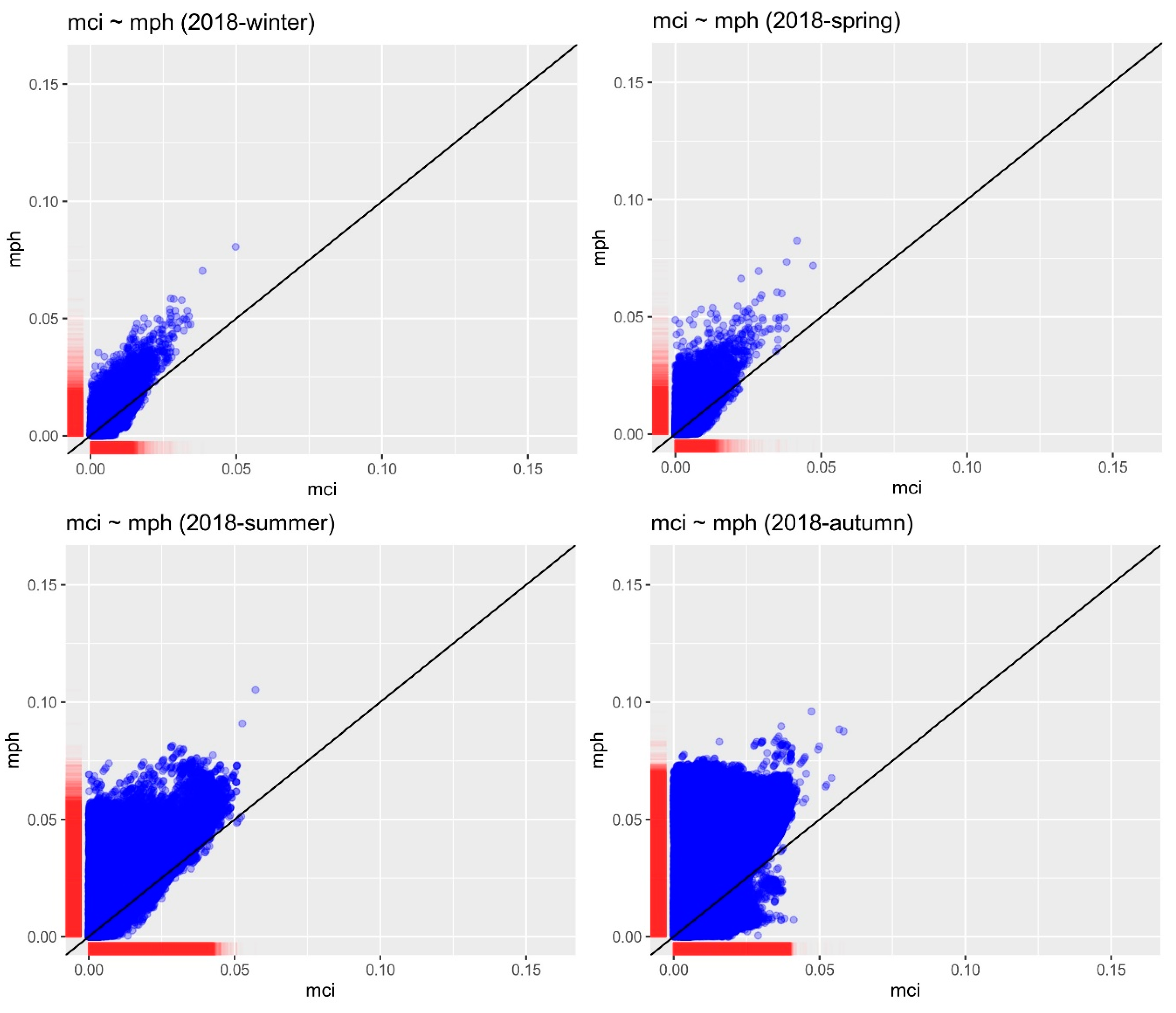
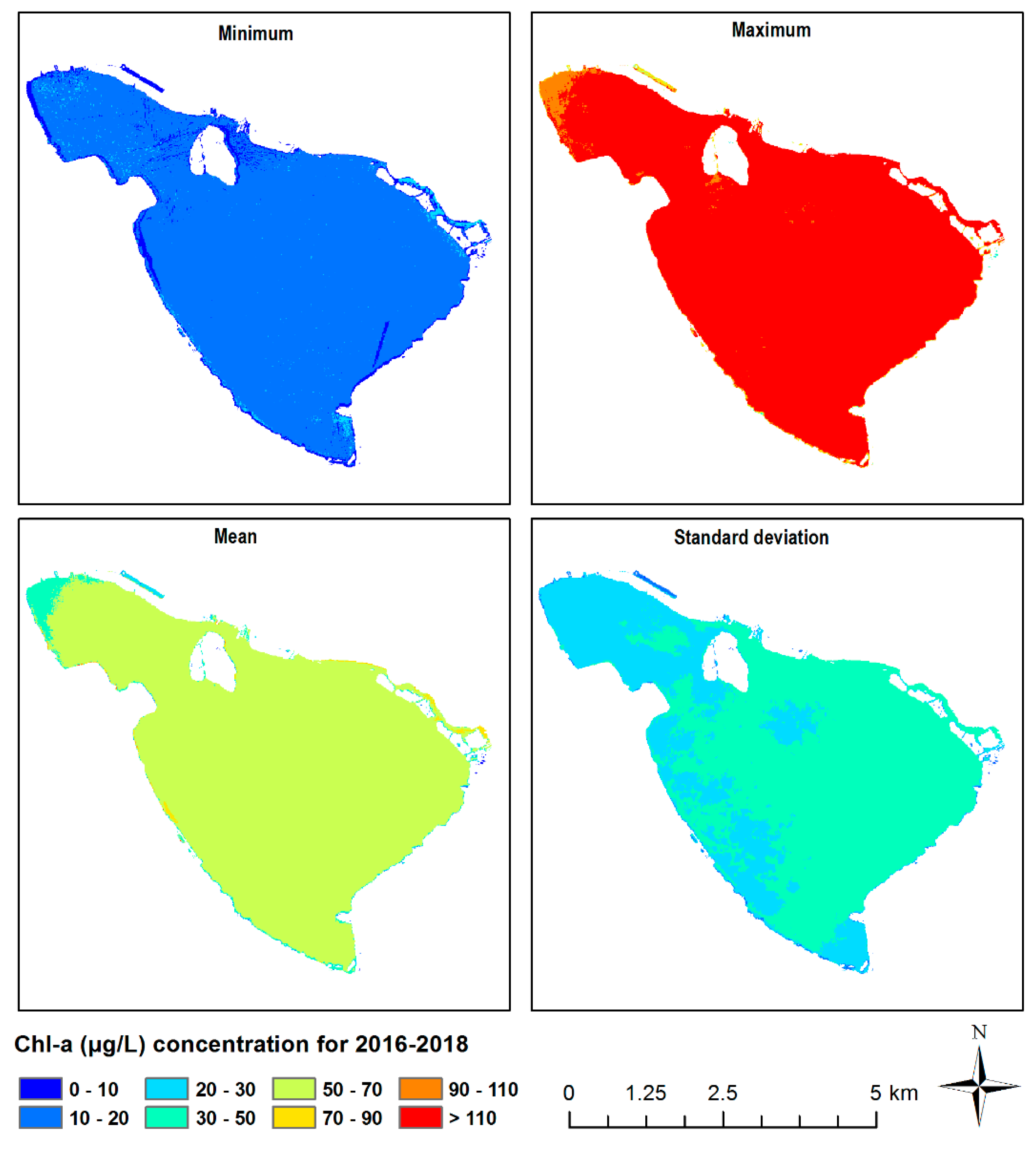
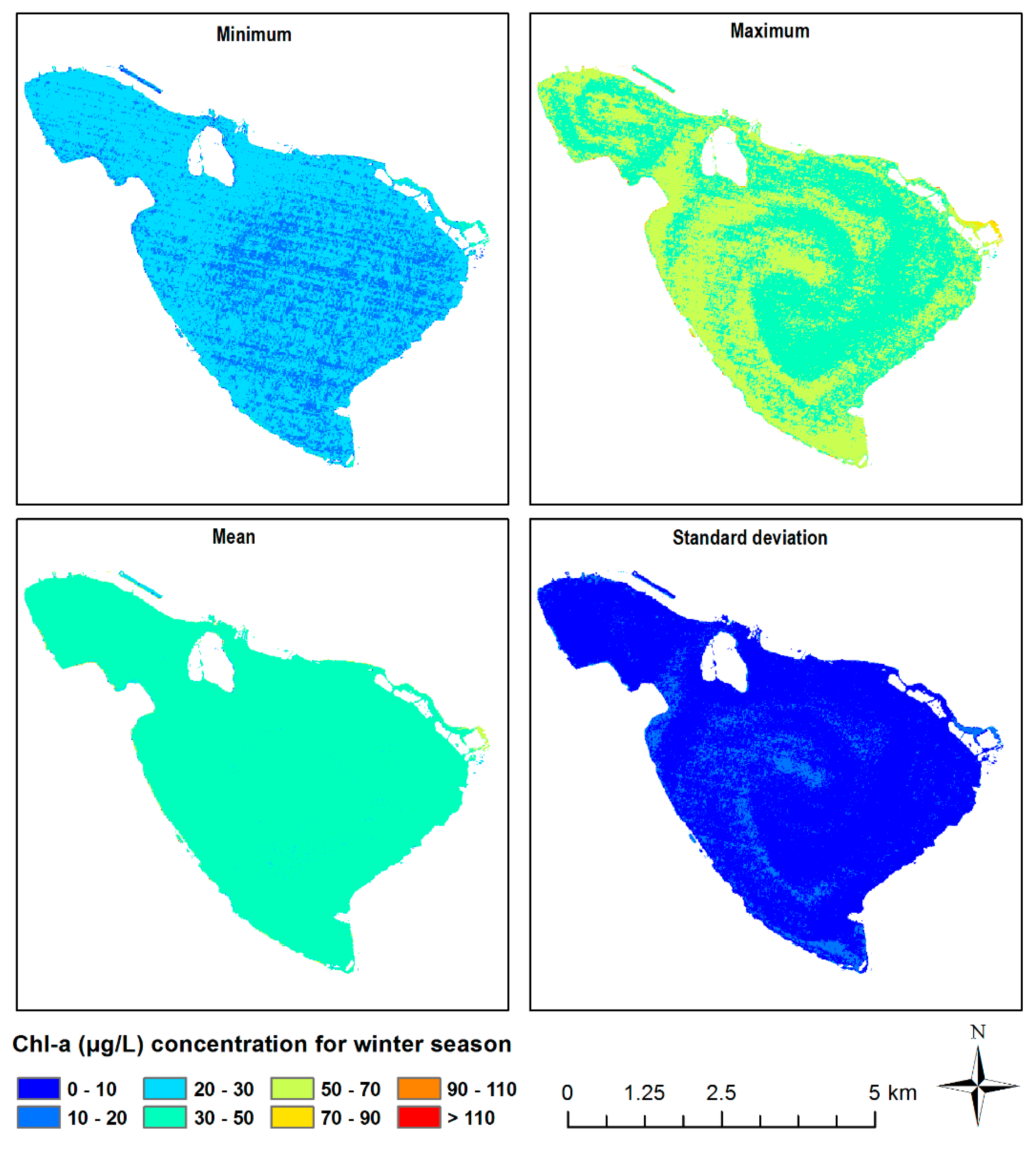

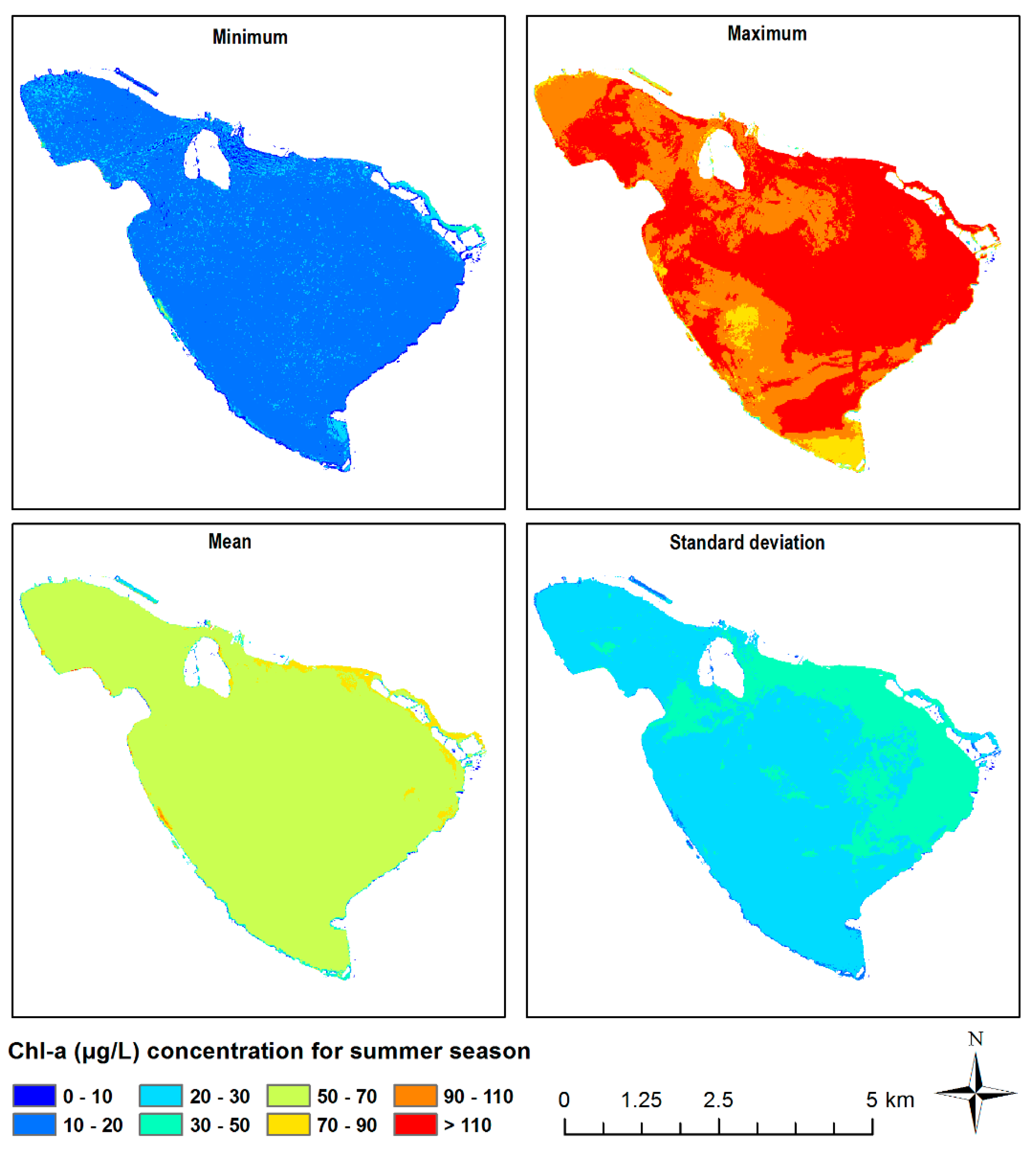
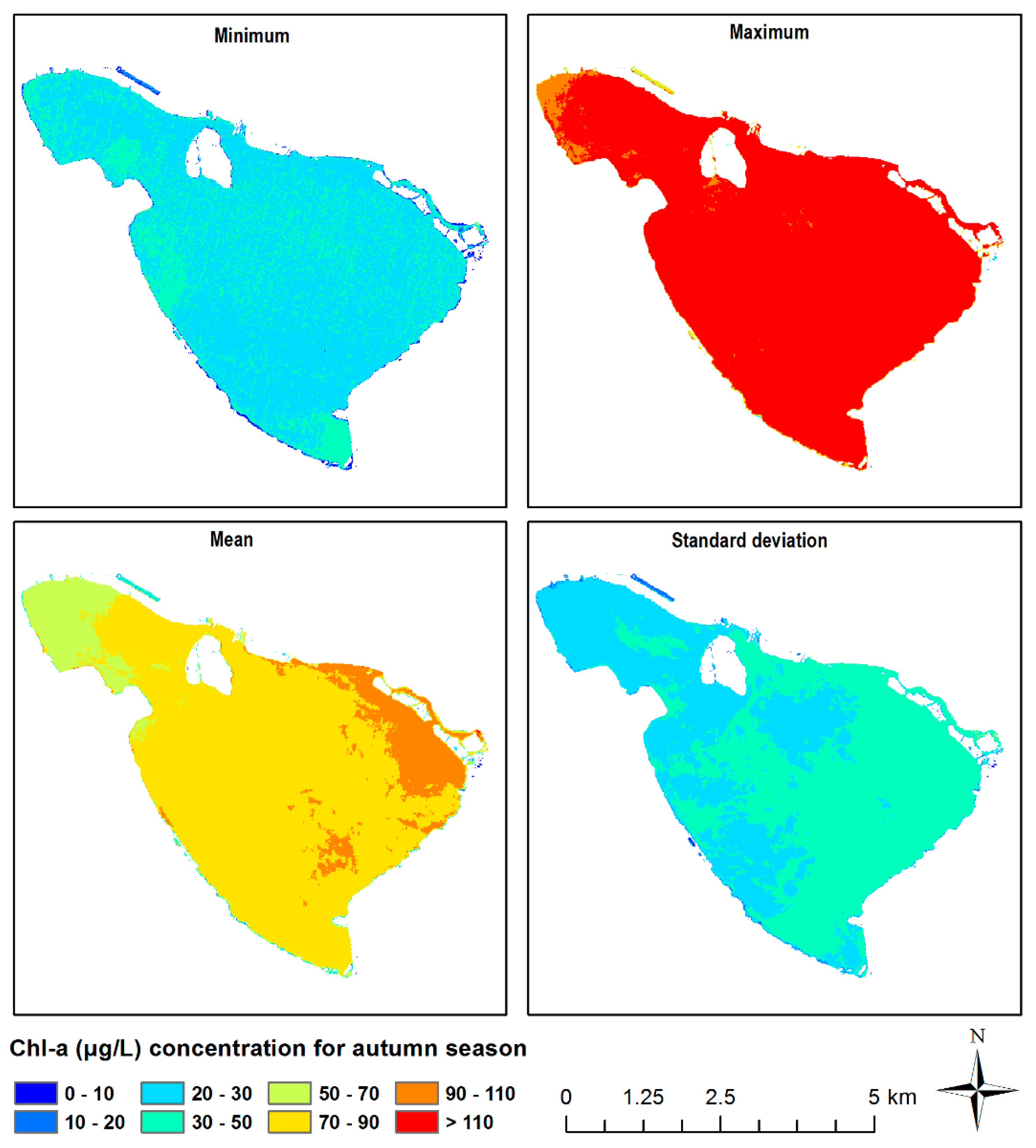
References
- Chaplin, M.F. Water: Its importance to life. Biochem. Mol. Biol. Educ. 2001, 29, 54–59. [Google Scholar] [CrossRef]
- Kagalou, I.; Tsimarakis, G.; Paschos, I. Water chemistry and biology in a shallow lake (Lake pamvotis- Greece). present state and perspectives. Glob. Nest J. 2001, 3, 85–94. [Google Scholar]
- Khan, M.N.; Mohammad, F. Eutrophication: Challenges and solutions. In Eutrophication: Causes, Consequences and Control; Springer: Dordrecht, The Netherlands, 2014; ISBN 9789400778146. [Google Scholar]
- Jensen, J.R. Remote Sensing of the Environment: An Earth Resource Perspective, 2nd ed.; Pearson Education Limited: Harlow, UK, 2014; ISBN 9780131889507. [Google Scholar]
- Hovis, W.A.; Clark, D.K.; Anderson, F.; Austin, R.W.; Wilson, W.H.; Baker, E.T.; Ball, D.; Gordon, H.R.; Mueller, J.L.; El-Sayed, S.Z.; et al. Nimbus-7 coastal zone color scanner: System description and initial imagery. Science 1980, 210, 60–63. [Google Scholar] [CrossRef]
- Kravitz, J.; Matthews, M.; Bernard, S.; Griffith, D. Application of Sentinel 3 OLCI for chl-a retrieval over small inland water targets: Successes and challenges. Remote Sens. Environ. 2020, 237, 111562. [Google Scholar] [CrossRef]
- Cazzaniga, I.; Bresciani, M.; Colombo, R.; Della Bella, V.; Padula, R.; Giardino, C. A comparison of Sentinel-3-OLCI and Sentinel-2-MSI-derived Chlorophyll- a maps for two large Italian lakes. Remote Sens. Lett. 2019, 10, 978–987. [Google Scholar] [CrossRef]
- Kondraju, T.T.; Rajan, K.S. Water Quality in Inland Water Bodies: Hostage to the Intensification of Anthropogenic Land Uses. J. Indian Soc. Remote Sens. 2019, 47, 1865–1874. [Google Scholar] [CrossRef]
- Watanabe, F.; Alcântara, E.; Bernardo, N.; de Andrade, C.; Gomes, A.C.; do Carmo, A.; Rodrigues, T.; Rotta, L.H. Mapping the chlorophyll-a horizontal gradient in a cascading reservoirs system using MSI Sentinel-2A images. Adv. Space Res. 2019, 64, 581–590. [Google Scholar] [CrossRef]
- Xu, M.; Liu, H.; Beck, R.; Lekki, J.; Yang, B.; Shu, S.; Kang, E.L.; Anderson, R.; Johansen, R.; Emery, E.; et al. A spectral space partition guided ensemble method for retrieving chlorophyll-a concentration in inland waters from Sentinel-2A satellite imagery. J. Great Lakes Res. 2019, 45, 454–465. [Google Scholar] [CrossRef]
- Toming, K.; Kutser, T.; Laas, A.; Sepp, M.; Paavel, B.; Nõges, T. First experiences in mapping lakewater quality parameters with sentinel-2 MSI imagery. Remote Sens. 2016, 8, 640. [Google Scholar] [CrossRef] [Green Version]
- Ha, N.T.T.; Thao, N.T.P.; Koike, K.; Nhuan, M.T. Selecting the best band ratio to estimate chlorophyll-a concentration in a tropical freshwater lake using sentinel 2A images from a case study of Lake Ba Be (Northern Vietnam). ISPRS Int. J. Geo.Inf. 2017, 6, 290. [Google Scholar] [CrossRef]
- Dörnhöfer, K.; Klinger, P.; Heege, T.; Oppelt, N. Multi-sensor satellite and in situ monitoring of phytoplankton development in a eutrophic-mesotrophic lake. Sci. Total Environ. 2018, 612, 1200–1214. [Google Scholar] [CrossRef] [PubMed]
- Poddar, S.; Chacko, N.; Swain, D. Estimation of Chlorophyll-a in Northern Coastal Bay of Bengal Using Landsat-8 OLI and Sentinel-2 MSI Sensors. Front. Mar. Sci. 2019, 6, 598. [Google Scholar] [CrossRef]
- Binding, C.E.; Greenberg, T.A.; Bukata, R.P. The MERIS Maximum Chlorophyll Index; its merits and limitations for inland water algal bloom monitoring. J. Great Lakes Res. 2013, 39, 100–107. [Google Scholar] [CrossRef]
- Gower, J.; King, S.; Goncalves, P. Global monitoring of plankton blooms using MERIS MCI. Proc. Int. J. Remote Sens. 2008, 29, 3209–6216. [Google Scholar] [CrossRef]
- Mollaee, S. Estimation of Phytoplankton Chlorophyll-a Concentration in the Western Basin of Lake Erie Using Sentinel-2 and Sentinel-3 Data. Master’s Thesis, University of Waterloo, Waterloo, ON, Canada, 2018. [Google Scholar]
- Grendaitė, D.; Stonevičius, E.; Karosienė, J.; Savadova, K.; Kasperovičienė, J. Chlorophyll-a concentration retrieval in eutrophic lakes in Lithuania from Sentinel-2 data. Geol. Geogr. 2018, 4, 15–28. [Google Scholar] [CrossRef]
- Matthews, M.W.; Bernard, S.; Robertson, L. An algorithm for detecting trophic status (chlorophyll-a), cyanobacterial-dominance, surface scums and floating vegetation in inland and coastal waters. Remote Sens. Environ. 2012, 124, 637–652. [Google Scholar] [CrossRef]
- Gower, J.F.R.; Doerffer, R.; Borstad, G.A. Interpretation of the 685nm peak in water-leaving radiance spectra in terms of fluorescence, absorption and scattering, and its observation by MERIS. Int. J. Remote Sens. 1999, 20, 1771–1786. [Google Scholar] [CrossRef]
- Soriano-González, J.; Angelats, E.; Fernández-Tejedor, M.; Diogene, J.; Alcaraz, C. First results of phytoplankton spatial dynamics in two NW-Mediterranean bays from chlorophyll-A estimates using Sentinel 2: Potential implications for aquaculture. Remote Sens. 2019, 20, 1756. [Google Scholar] [CrossRef] [Green Version]
- Elhag, M.; Gitas, I.; Othman, A.; Bahrawi, J.; Gikas, P. Assessment of water quality parameters using temporal remote sensing spectral reflectance in arid environments, Saudi Arabia. Water Switzerland 2019, 11, 556. [Google Scholar] [CrossRef] [Green Version]
- Kagalou, I.; Papastergiadou, E.; Leonardos, I. Long term changes in the eutrophication process in a shallow Mediterranean lake ecosystem of W. Greece: Response after the reduction of external load. J. Environ. Manag. 2008, 87, 497–506. [Google Scholar] [CrossRef]
- Papatheodorou, G.; Demopoulou, G.; Lambrakis, N. A long-term study of temporal hydrochemical data in a shallow lake using multivariate statistical techniques. Ecol. Model. 2006, 193, 759–776. [Google Scholar] [CrossRef]
- Papastergiadou, E.; Kagalou, I.; Stefanidis, K.; Retalis, A.; Leonardos, I. Effects of anthropogenic influences on the trophic state, land uses and aquatic vegetation in a shallow Mediterranean lake: Implications for restoration. Water Resour. Manag. 2010, 24, 415–435. [Google Scholar] [CrossRef]
- Romero, J.R.; Kagalou, I.; Imberger, J.; Hela, D.; Kotti, M.; Bartzokas, A.; Albanis, T.; Evmirides, N.; Karkabounas, S.; Papagiannis, J.; et al. Seasonal water quality of shallow and eutrophic Lake Pamvotis, Greece: Implications for restoration. Hydrobiologia 2002, 474, 91–105. [Google Scholar] [CrossRef]
- Yannopoulos, S.; Kaloyannis, H. Water quality modelling of the Pamvotis lake (Greece) using the wasp mathematical model. In Proceedings of the 2008 International Conference of Protection and Restoration of the Environment IX, Kefalonia Island, Greece, 30 June–03 July 2008. [Google Scholar]
- Hadjisolomou, E.; Stefanidis, K.; Papatheodorou, G.; Papastergiadou, E. Assessing the contribution of the environmental parameters to eutrophication with the use of the “PaD” and “PaD2” methods in a hypereutrophic lake. Int. J. Environ. Res. Public Health 2016, 13, 764. [Google Scholar] [CrossRef] [PubMed] [Green Version]
- Hadjisolomou, E.; Stefanidis, K.; Papatheodorou, G.; Papastergiadou, E. Evaluating the contributing environmental parameters associated with eutrophication in a shallow lake by applying artificial neural networks techniques. Fresenius Environ. Bull. 2017, 26, 3200–3208. [Google Scholar]
- Kati, V.; Mani, P.; von Helversen, O.; Willemse, F.; Elsner, N.; Dimopoulos, P. Human land use threatens endemic wetland species: The case of Chorthippus lacustris (La Greca and Messina 1975) (Orthoptera: Acrididae) in Epirus, Greece. J. Insect Conserv. 2006, 10, 65–74. [Google Scholar] [CrossRef]
- Chiotelli, E.P. Evaluation of the Effects of Irrigation and Drainage Practices on the Landscape of Lake Pamvotis, Ioannina: Implications for Landscape Management in the Context of Sustainability. Agric. Agric. Sci. Procedia 2015, 4, 201–210. [Google Scholar] [CrossRef]
- McFeeters, S.K. The use of the Normalized Difference Water Index (NDWI) in the delineation of open water features. Int. J. Remote Sens. 1996, 17, 1425–1432. [Google Scholar] [CrossRef]
- Illian, J.; Penttinen, A.; Stoyan, H.; Stoyan, D. Statistical Analysis and Modelling of Spatial Point Patterns; John Wiley and Sons: New York, NY, USA, 2008; ISBN 9780470725160. [Google Scholar]
- Whaley, D.L. The Interquartile Range: Theory and Estimation. Electronic Theses and Dissertations. Bachelor’s Thesis, East Tennessee State University, Johnson City, TN, USA, 2005. [Google Scholar]
- Memarsadeghi, N.; Mount, D.M.; Netanyahu, N.S.; Le Moigne, J. A fast implementation of the isodata clustering algorithm. Proc. Int. J. Comput. Geom. Appl. 2007, 17, 71–103. [Google Scholar] [CrossRef]
- Jain, A.K. Data clustering: 50 years beyond K-means. Pattern Recognit. Lett. 2010, 31, 651–666. [Google Scholar] [CrossRef]
- Li, B.; Zhao, H.; Lv, Z.H. Parallel ISODATA clustering of remote sensing images based on MapReduce. In Proceedings of the 2010 International Conference on Cyber-Enabled Distributed Computing and Knowledge Discovery, Huangshan, China, 10–12 October 2010. [Google Scholar]
- Charrad, M.; Ghazzali, N.; Boiteau, V.; Niknafs, A. NbClust: An R Package for Determining the Relevant Number of Clusters in a Data Set. J. Stat. Softw. 2014, 61, 1–36. [Google Scholar] [CrossRef] [Green Version]
- Matthews, M.W.; Odermatt, D. Improved algorithm for routine monitoring of cyanobacteria and eutrophication in inland and near-coastal waters. Remote Sens. Environ. 2015, 156, 374–382. [Google Scholar] [CrossRef]
- Tao, B.; Mao, Z.; Pan, D.; Shen, Y.; Zhu, Q.; Chen, J. Influence of bio-optical parameter variability on the reflectance peak position in the red band of algal bloom waters. Ecol. Inform. 2013, 16, 17–24. [Google Scholar] [CrossRef]
- Liang, Q.; Zhang, Y.; Ma, R.; Loiselle, S.; Li, J.; Hu, M. A MODIS-based novel method to distinguish surface cyanobacterial scums and aquatic macrophytes in Lake Taihu. Remote Sens. 2017, 9, 133. [Google Scholar] [CrossRef] [Green Version]
- Sterckx, S.; Knaeps, E.; Ruddick, K. Detection and correction of adjacency effects in hyperspectral airborne data of coastal and inland waters: The use of the near infrared similarity spectrum. Int. J. Remote Sens. 2011, 32, 6479–6505. [Google Scholar] [CrossRef]
- Chang, Y.; Yan, L.; Wu, T.; Zhong, S. Remote Sensing Image Stripe Noise Removal: From Image Decomposition Perspective. IEEE Trans. Geosci. Remote Sens. 2016, 32, 6479–6505. [Google Scholar] [CrossRef]
- Chen, Y.; Huang, T.Z.; Zhao, X.L.; Deng, L.J.; Huang, J. Stripe noise removal of remote sensing images by total variation regularization and group sparsity constraint. Remote Sens. 2017, 54, 559. [Google Scholar] [CrossRef] [Green Version]
- Kääb, A.; Winsvold, S.H.; Altena, B.; Nuth, C.; Nagler, T.; Wuite, J. Glacier remote sensing using sentinel-2. part I: Radiometric and geometric performance, and application to ice velocity. Remote Sens. 2016, 8, 598. [Google Scholar] [CrossRef] [Green Version]
- Xia, R.; Zhang, Y.; Critto, A.; Wu, J.; Fan, J.; Zheng, Z.; Zhang, Y. The potential impacts of climate change factors on freshwater eutrophication: Implications for research and countermeasures of water management in China. Sustainability 2016, 8, 229. [Google Scholar] [CrossRef] [Green Version]
- Serwan, M.J.B. Trophic classification and ecosystem checking of lakes using remotely sensed information. Hydrol. Sci. J. 1996, 41, 939–957. [Google Scholar]
- Nitas, P. Lake Pamvotis Water Monitoring Program. Available online: http://www.lakepamvotis.gr/img/monitoring/Monitoring_Nitas_P.pdf (accessed on 12 February 2020).
- Kopsidas, O. Valuation of the External Cost Caused by the Environmental Pollution of Three Lakes in Northern Greece. J. Environ. Sci. Eng. A 2018, 7, 140–145. [Google Scholar] [CrossRef]


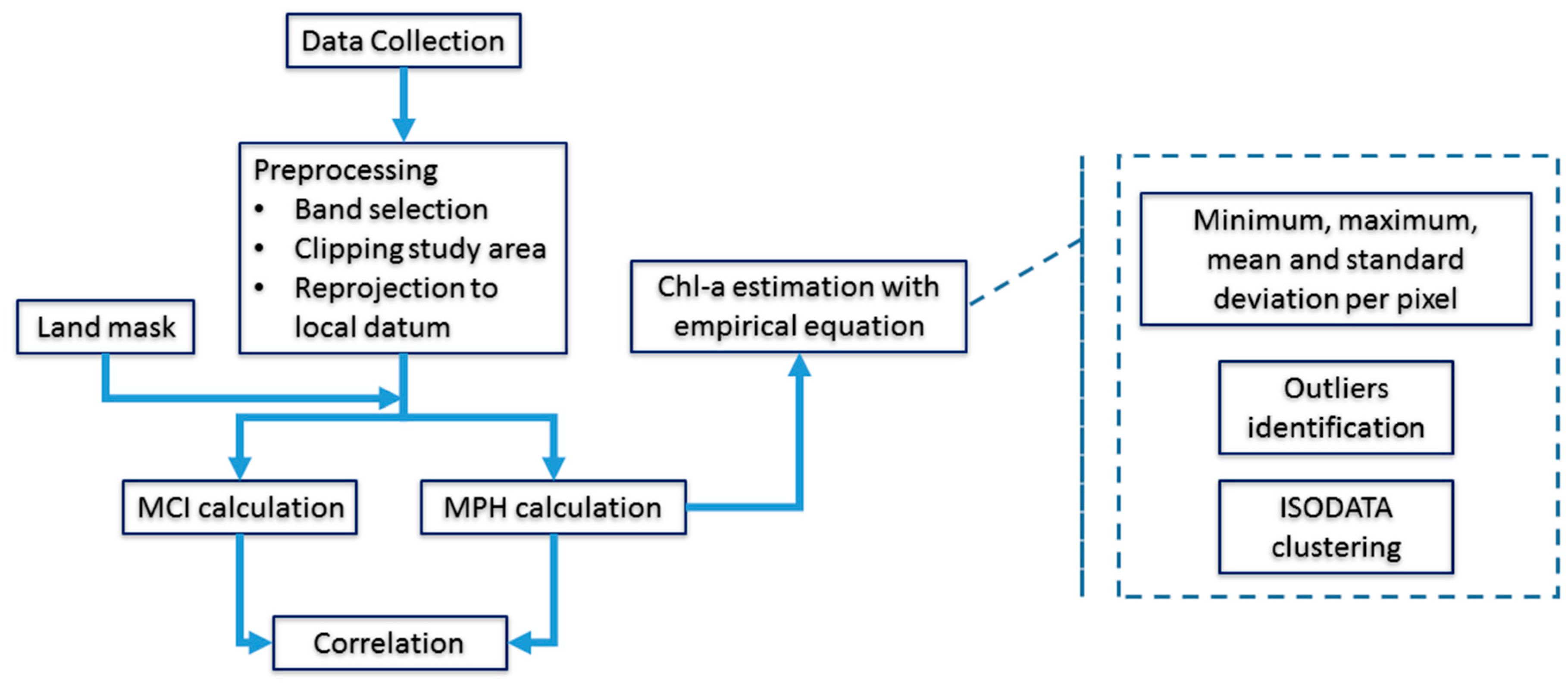



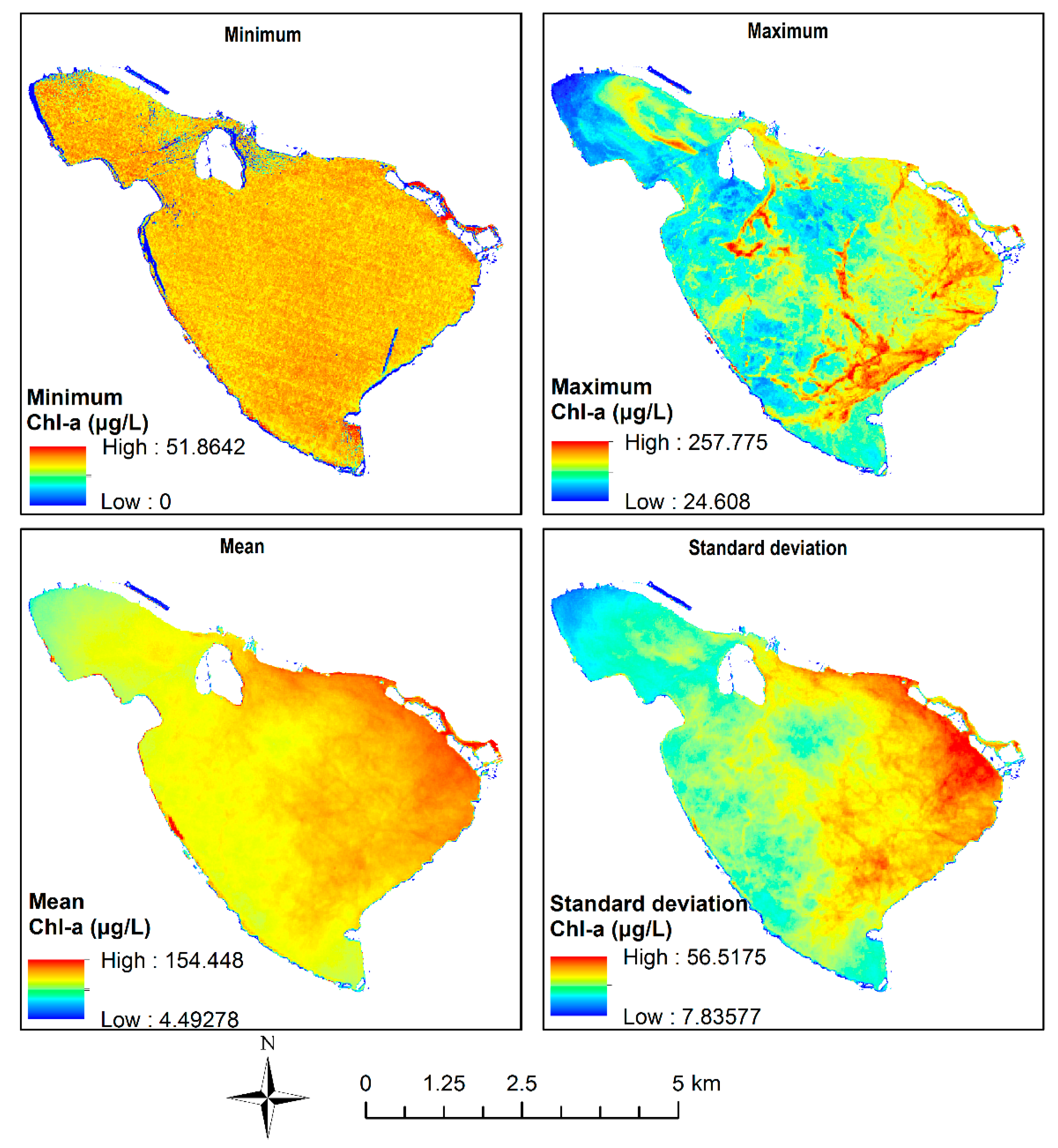
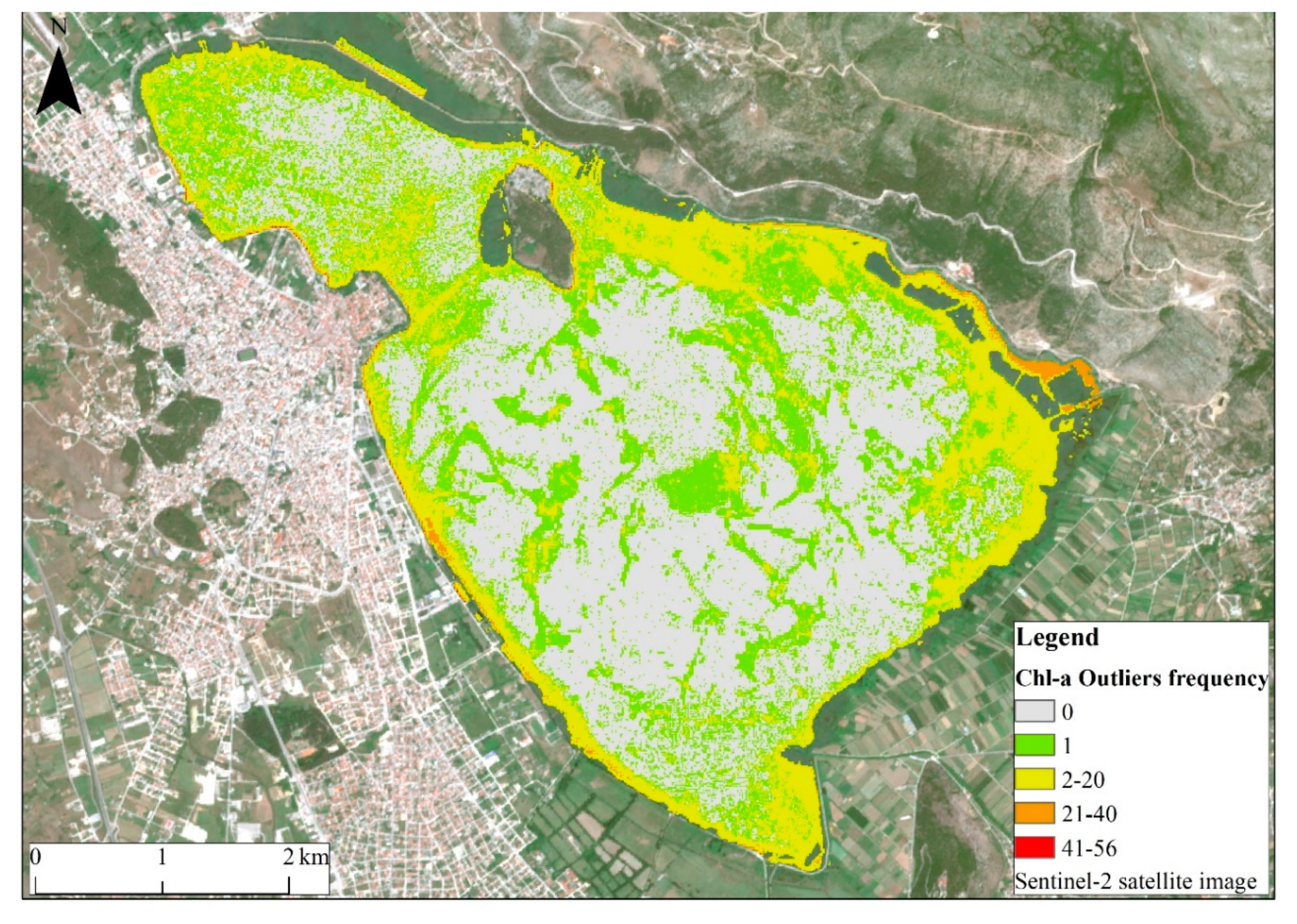

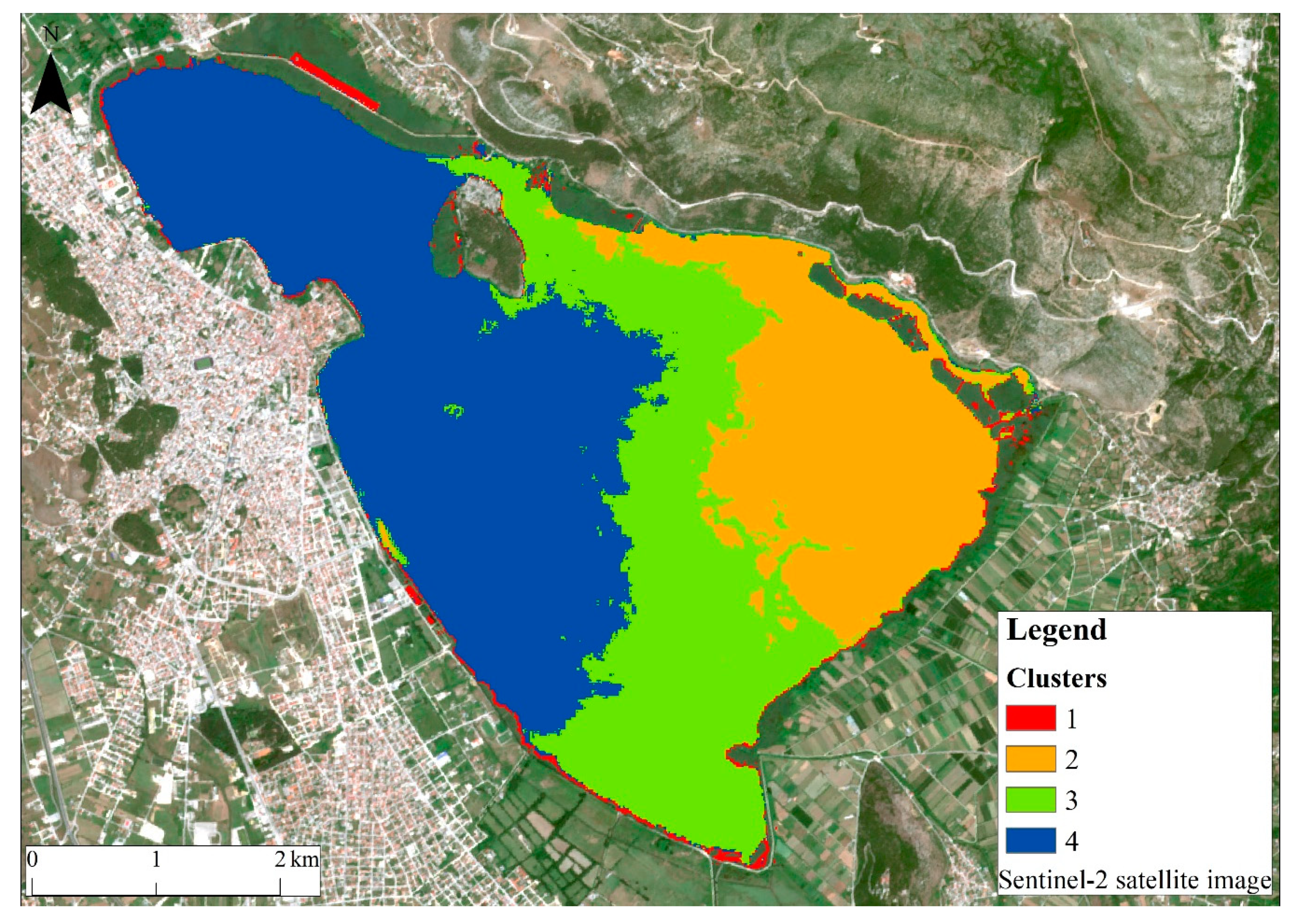
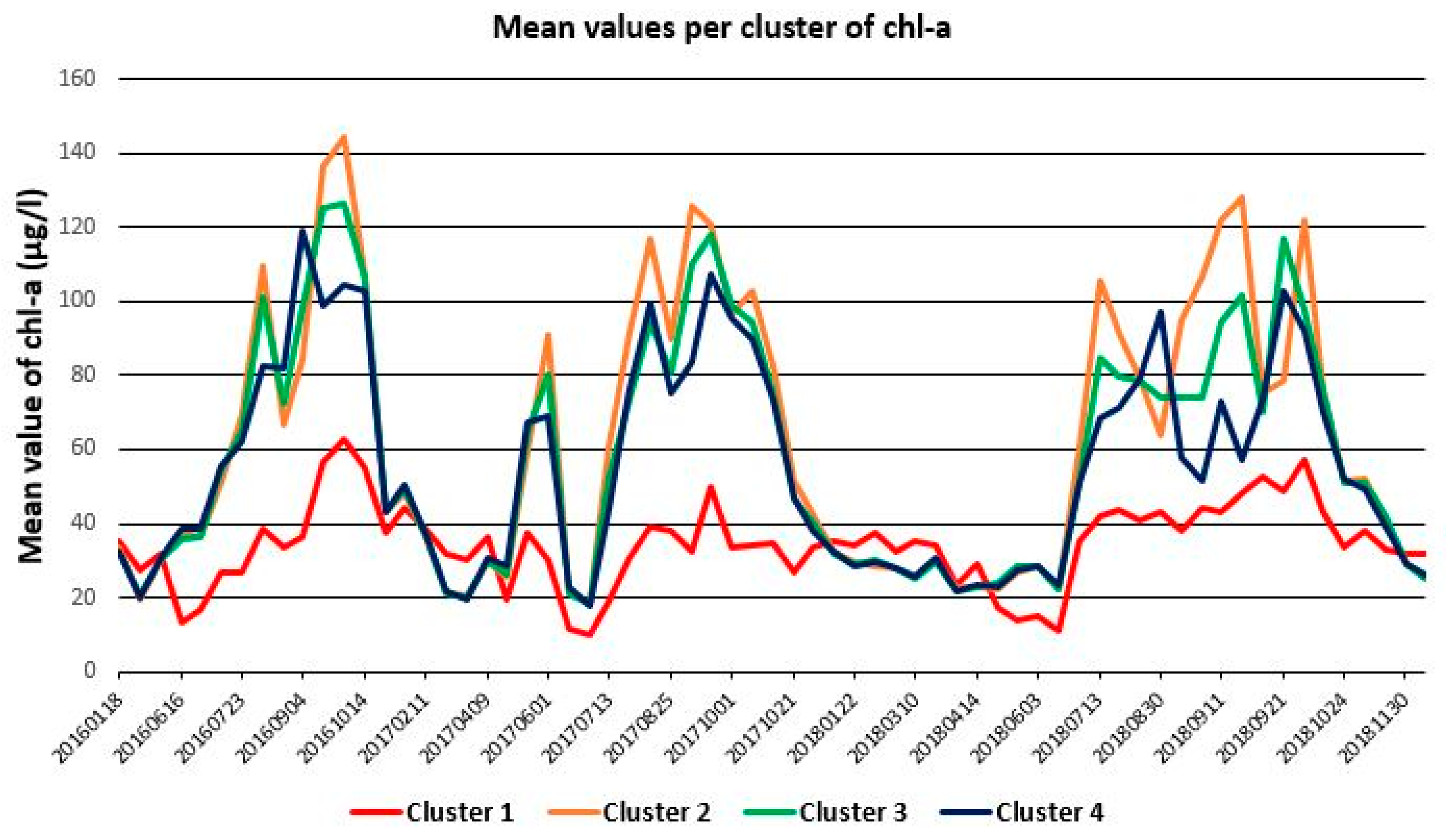
| Annual | Winter | Spring | Summer | Autumn | |
|---|---|---|---|---|---|
| 2016 | 0.92 | 0.88 | 0.66 | 0.95 | 0.70 |
| 2017 | 0.75 | 0.77 | 0.92 | 0.89 | 0.48 |
| 2018 | 0.82 | 0.81 | 0.62 | 0.85 | 0.65 |
© 2020 by the authors. Licensee MDPI, Basel, Switzerland. This article is an open access article distributed under the terms and conditions of the Creative Commons Attribution (CC BY) license (http://creativecommons.org/licenses/by/4.0/).
Share and Cite
Peppa, M.; Vasilakos, C.; Kavroudakis, D. Eutrophication Monitoring for Lake Pamvotis, Greece, Using Sentinel-2 Data. ISPRS Int. J. Geo-Inf. 2020, 9, 143. https://doi.org/10.3390/ijgi9030143
Peppa M, Vasilakos C, Kavroudakis D. Eutrophication Monitoring for Lake Pamvotis, Greece, Using Sentinel-2 Data. ISPRS International Journal of Geo-Information. 2020; 9(3):143. https://doi.org/10.3390/ijgi9030143
Chicago/Turabian StylePeppa, Maria, Christos Vasilakos, and Dimitris Kavroudakis. 2020. "Eutrophication Monitoring for Lake Pamvotis, Greece, Using Sentinel-2 Data" ISPRS International Journal of Geo-Information 9, no. 3: 143. https://doi.org/10.3390/ijgi9030143
APA StylePeppa, M., Vasilakos, C., & Kavroudakis, D. (2020). Eutrophication Monitoring for Lake Pamvotis, Greece, Using Sentinel-2 Data. ISPRS International Journal of Geo-Information, 9(3), 143. https://doi.org/10.3390/ijgi9030143







